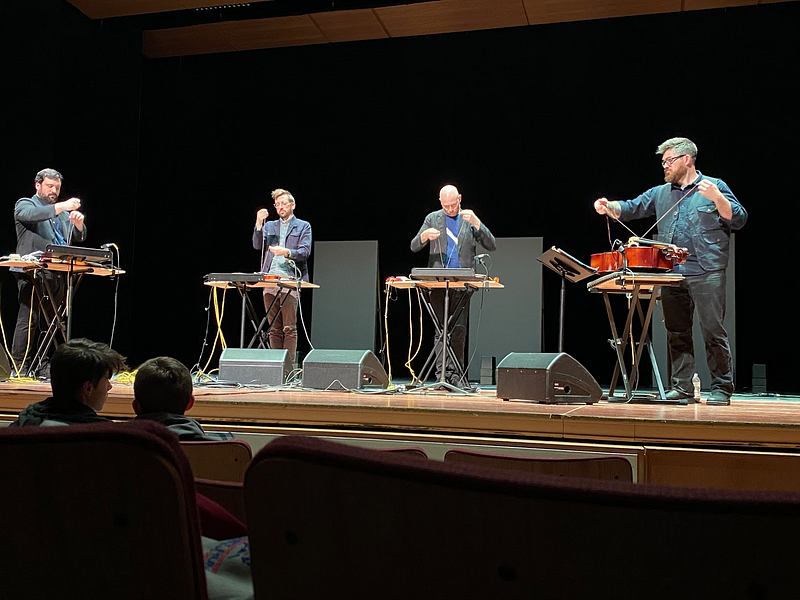
On Friday, Feb. 28, musical group Sō Percussion performed in Wellin Hall, with a full performance at 7:30 p.m. and a “teaser” concert earlier at noon. Open to both the Hamilton and the Clinton communities, the group’s nontraditional twist on percussion drew a large crowd. Sō Percussion works to transform the definition of percussion through expanding the use of instruments beyond typical ones like drums, tambourines, cymbals, and xylophones.
Comprised of four Princeton University professors, the group has performed on stages across the globe. Josh Quillen, Adam Sliwinski, Jason Treuting, and Eric Cha-Beach have taken their musical experiences and projects as professors on the road and are well known for their nine studio albums. According to Performing Arts Administrator Michelle Reiser-Memmer, “Sō Percussion has redefined the scope and role of the modern percussion ensemble, placing it at the leading edge of 21st-century music.” For Friday’s show, which focused on “The Quartet Reimagined,” founding member Jason Treuting spoke to the audience between pieces to explain how that night’s ensemble was “an entirely new show.”
The show had five acts, each with their own spin on a different unconventional style of percussion. The show opened with an act called “Music for Pieces of Wood.” Each member came on stage one by one and began to drum a piece of wood to their own rhythm. It was a comedic cold open, with much of the audience laughing as the banging on wood panels seemed to never end. At the conclusion of the piece, Treuting addressed the crowd and introduced his fellow members. He then explained that the group had performed at Colgate University and characterized their time there: “Well… it sucked.” The audience erupted in cheers, and Treuting triumphantly exclaimed, “Good to know I know how to read a room!”
“Water, Wine, Brandy, Brine” followed “Music for Pieces of Wood.” The performers began by clinking glasses in pairs, creating a variety of sounds based on the shapes of the glasses and the amount of water in them. The group went on to tap the glasses with a striker to create sharper noises, followed by placing their fingers on the rims of the glasses and circling the perimeter for extremely sharp yet calming notes. Tonwa Hauff ’23 said this was his favorite act because he “loved that they used only wine glasses to create such siren-Esque and enchanting melodies.”
In the following piece, “Construction,” the performers hit microphones against a section of wall or floor that Quillen had marked with duct tape. Treuting said their goal for “Construction” was to be able “to move and make sound in one piece.” As the members walked back and forth in a straight line, the microphones bounced off the frequencies of two speakers they passed, then were juxtaposed with the sudden bangs of the microphone hitting the surfaces. Emily Wong ’23 said that “Construction” was her favorite act of the show because “it wasn’t something that I’ve seen before, and I thought it was very neat.” Russell Chan ’23 agreed that “Construction” was his favorite because it had interesting rhythmic patterns. Hauff also found this piece to be intriguing. “Although I am a percussionist who is accustomed to really weird things, I have never seen a classic percussion quartet blend movement and sound as seamlessly as Sō Percussion did in “Construction,” said Hauff.
A brief intermission followed “Construction.” The performance resumed with “The Diamond in the Square.” During this piece, the members worked with the internal parts of a piano. Yarn and lobster cord ran through different sections of the piano to create satisfying sounds that worked in harmony with the piano keys being played.
For the finale, Sō Percussion played “Forbidden Love.” During this piece, the group played traditional string instruments such as a cello and viola on stands, and the members ran strikers in between the strings to create loud shrieking noises. The shrieks eventually became more manageable and “sounded like phone ringtones,” according to Wong. Chan added that this non-traditional use of instruments surprised him the most out of all of the acts.
Reisser-Memmer explained that Sō Percussion is “creating modern collaborations with artists who work outside the classical concert hall.” The Hamilton community witnessed just that on Friday night. Although neither Wong nor Chan would see the show again, they both recommend it for those who are interested in non-traditional and experimental music. Hauff, however, said the show was “extraordinarily entertaining” and had him “hooked from start to finish.” He would recommend Sō Percussion shows to others because their experimental “music tends to be more entertaining to people than a typical string quartet.”

















